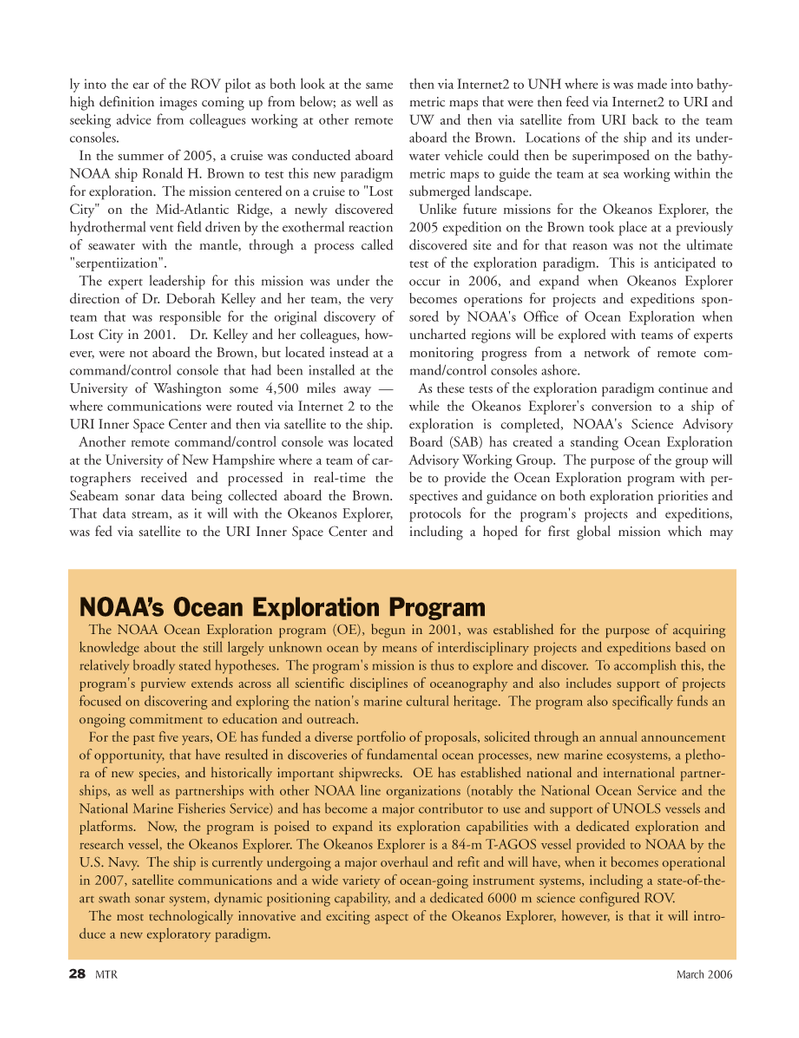
Page 27: of Marine Technology Magazine (March 2006)
AUVs; ROVs; UUVs
Read this page in Pdf, Flash or Html5 edition of March 2006 Marine Technology Magazine
28 MTR March 2006 ly into the ear of the ROV pilot as both look at the same high definition images coming up from below; as well as seeking advice from colleagues working at other remote consoles.
In the summer of 2005, a cruise was conducted aboard
NOAA ship Ronald H. Brown to test this new paradigm for exploration. The mission centered on a cruise to "Lost
City" on the Mid-Atlantic Ridge, a newly discovered hydrothermal vent field driven by the exothermal reaction of seawater with the mantle, through a process called "serpentiization".
The expert leadership for this mission was under the direction of Dr. Deborah Kelley and her team, the very team that was responsible for the original discovery of
Lost City in 2001. Dr. Kelley and her colleagues, how- ever, were not aboard the Brown, but located instead at a command/control console that had been installed at the
University of Washington some 4,500 miles away — where communications were routed via Internet 2 to the
URI Inner Space Center and then via satellite to the ship.
Another remote command/control console was located at the University of New Hampshire where a team of car- tographers received and processed in real-time the
Seabeam sonar data being collected aboard the Brown.
That data stream, as it will with the Okeanos Explorer, was fed via satellite to the URI Inner Space Center and then via Internet2 to UNH where is was made into bathy- metric maps that were then feed via Internet2 to URI and
UW and then via satellite from URI back to the team aboard the Brown. Locations of the ship and its under- water vehicle could then be superimposed on the bathy- metric maps to guide the team at sea working within the submerged landscape.
Unlike future missions for the Okeanos Explorer, the 2005 expedition on the Brown took place at a previously discovered site and for that reason was not the ultimate test of the exploration paradigm. This is anticipated to occur in 2006, and expand when Okeanos Explorer becomes operations for projects and expeditions spon- sored by NOAA's Office of Ocean Exploration when uncharted regions will be explored with teams of experts monitoring progress from a network of remote com- mand/control consoles ashore.
As these tests of the exploration paradigm continue and while the Okeanos Explorer's conversion to a ship of exploration is completed, NOAA's Science Advisory
Board (SAB) has created a standing Ocean Exploration
Advisory Working Group. The purpose of the group will be to provide the Ocean Exploration program with per- spectives and guidance on both exploration priorities and protocols for the program's projects and expeditions, including a hoped for first global mission which may
NOAA’s Ocean Exploration Program
The NOAA Ocean Exploration program (OE), begun in 2001, was established for the purpose of acquiring knowledge about the still largely unknown ocean by means of interdisciplinary projects and expeditions based on relatively broadly stated hypotheses. The program's mission is thus to explore and discover. To accomplish this, the program's purview extends across all scientific disciplines of oceanography and also includes support of projects focused on discovering and exploring the nation's marine cultural heritage. The program also specifically funds an ongoing commitment to education and outreach.
For the past five years, OE has funded a diverse portfolio of proposals, solicited through an annual announcement of opportunity, that have resulted in discoveries of fundamental ocean processes, new marine ecosystems, a pletho- ra of new species, and historically important shipwrecks. OE has established national and international partner- ships, as well as partnerships with other NOAA line organizations (notably the National Ocean Service and the
National Marine Fisheries Service) and has become a major contributor to use and support of UNOLS vessels and platforms. Now, the program is poised to expand its exploration capabilities with a dedicated exploration and research vessel, the Okeanos Explorer. The Okeanos Explorer is a 84-m T-AGOS vessel provided to NOAA by the
U.S. Navy. The ship is currently undergoing a major overhaul and refit and will have, when it becomes operational in 2007, satellite communications and a wide variety of ocean-going instrument systems, including a state-of-the- art swath sonar system, dynamic positioning capability, and a dedicated 6000 m science configured ROV.
The most technologically innovative and exciting aspect of the Okeanos Explorer, however, is that it will intro- duce a new exploratory paradigm.
MTR#2 (17-32).qxd 2/23/2006 5:05 PM Page 28

 26
26

 28
28
